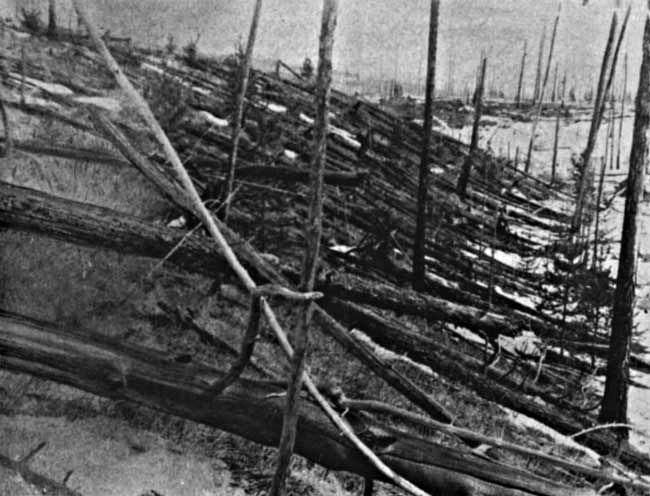 Trees knocked over by the Tunguska blast. Photograph from the Soviet Academy of Science 1927 expedition led by Leonid Kulik.
Trees knocked over by the Tunguska blast. Photograph from the Soviet Academy of Science 1927 expedition led by Leonid Kulik.
Orwell Astronomical Society (Ipswich)
The Tunguska Event
At 7.17 am on 30 June 1908, an explosion of catastrophic proportions rocked the desolate, pine-forested area of Tunguska in Northern Siberia, 3500 km east of Moscow. The explosion was seen up to 500 km away, was felt nearly 650 km away, and was heard over 800 km away. All over Europe there were reports of strange glows of various colours in the sky. Eye-witnesses near the centre of the explosion spoke of a brilliant blue, log-shaped object hurtling through the sky and exploding with a blinding flash and a roar. Despite the size and ferocity of the explosion, only a few dozen wandering herdsmen were killed, as the area was almost totally uninhabited.
It was impossible to get an investigative team to the area because of the hostile climate and terrain, and the official Russian explanation of a falling meteorite was accepted in scientific circles. However, a professor of Leningrad Mineralogical Museum, Leonid Kulik, was determined to discover the site, and finally took an expedition there in 1927 at the fourth attempt, to view an amazing sight. Four thousand square kilometres of forest had been charred and flattened, the fallen trunks all pointing away from a central spot like spokes in a giant wheel. In the centre, there was no crater but a grove of trees still standing upright, stripped of all branches and burnt almost to a cinder. The team dug for fragments to support the meteorite theory, but found nothing. They did discover that newly sprouted trees were growing four times faster than normal, and they found out from local herdsmen that reindeer herds had been covered in sores and scabs after the explosion. Although Professor Kulik did not know it, the facts pointed to a nuclear explosion having occurred about five miles above the Earth's surface, some 1500 times more powerful than the atom bomb that destroyed Hiroshima, long before the atom bomb was invented.
 Trees knocked over by the Tunguska blast. Photograph from the Soviet Academy of Science 1927 expedition led by Leonid Kulik.
Trees knocked over by the Tunguska blast. Photograph from the Soviet Academy of Science 1927 expedition led by Leonid Kulik.
After the results of the Hiroshima and Nagasaki bombs became known, the Russians launched a full-scale scientific investigation of the Tanguska event. A Russian expedition to the site in 1961 found evidence of a nuclear explosion. Radioactivity in the area was double the background count, and genetic mutation had caused plant growth to increase twelve-fold.
Alternative theories to the meteorite hypothesis were put forward by world scientists. Two American professors suggested that a black hole could have entered the Earth's atmosphere, producing a shock wave of atomic bomb proportions, and passed straight through the Earth without leaving a trace. But the theory did not tie-in with the eye-witness accounts of the blue, log-shaped object in the atmosphere. Russian scientist Dr Alexander Kazantev then proposed an explanation into which all the evidence slotted neatly. He suggested that a spaceship from another planet had exploded while trying to make an emergency landing. Several young Russian scientists adopted the theory and re-examined all the evidence from the perspective that it offered. Firstly, the area would be an obvious landing site, being almost totally uninhabited for miles around. New calculations revealed the speed of the object to be 30 km/s per second, about right for a space vehicle slowing down to land. The multi-coloured smoke described by some observers is consistent with vapour given off from disintegrating heat shields on space capsules. Soil brought back in 1927 was intensively examined and found to contain microscopic blobs of fused metal and glass with traces of cobalt, copper and germanium - elements not found in normal meteorites. There is a whole chapter on Tanguska in the book UFOs From Behind The Iron Curtain by Hobana & Weverbergh.
There are other possible explanations. For example, L Kresak in the Bulletin of the Astronomical Institutes of Czechoslovakia proposed, on the basis of re-evaluated data inferred from eye-witness accounts, that a fragment of Comet Encke caused the catastrophe. A small cometary fragment (say approximately 100 m in diameter) would have been visible for about an hour in the dawn sky before impact and could have caused the release of radioactivity when it struck the Earth. (The cometary explanation is supported by calculations by Dr John Brown of Glasgow University and Dr David Hughes of Sheffield University.) The co-ordinates of the Tanguska object match those of the Beta Taurid meteor shower, which was at its peak on the very day of the catastrophe. In fact, the Beta Taurids are caused by debris strewn in the wake of Comet Encke as it crosses the orbit of the Earth. The comet is a prolific source of interplanetary debris, and may well have produced several cometary fragments. Kresak favours an extinct remnant as the culprit rather than an active fragment, in view of the absence of sightings significantly before impact, and the estimated 100 m size of the Tanguska object.
So the mystery remains as to the cause of the event. Meanwhile, the Russians are at present engaged in another exhaustive re-investigation, the findings of which are due to be published in 1978.
Paul Burt and Mark Howe